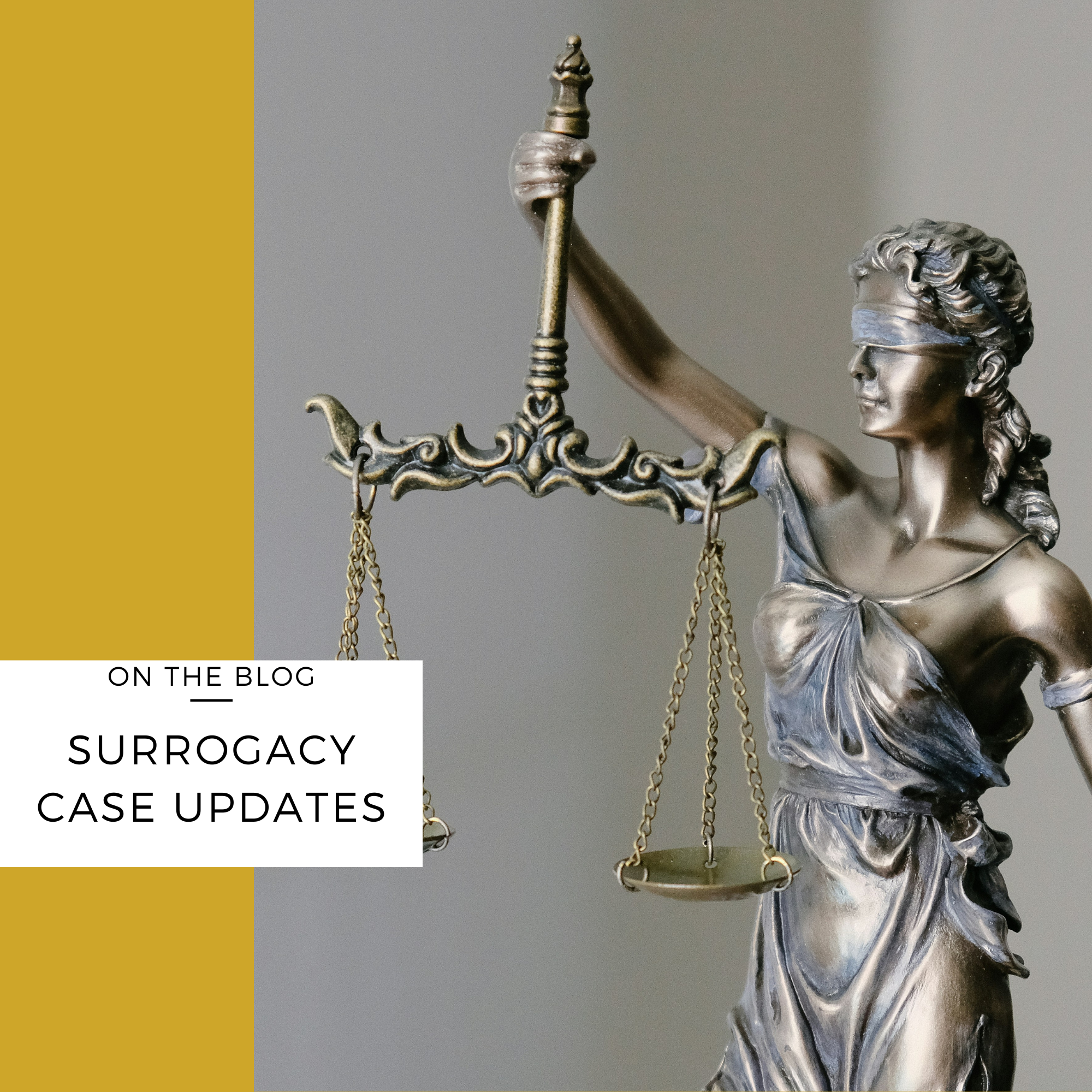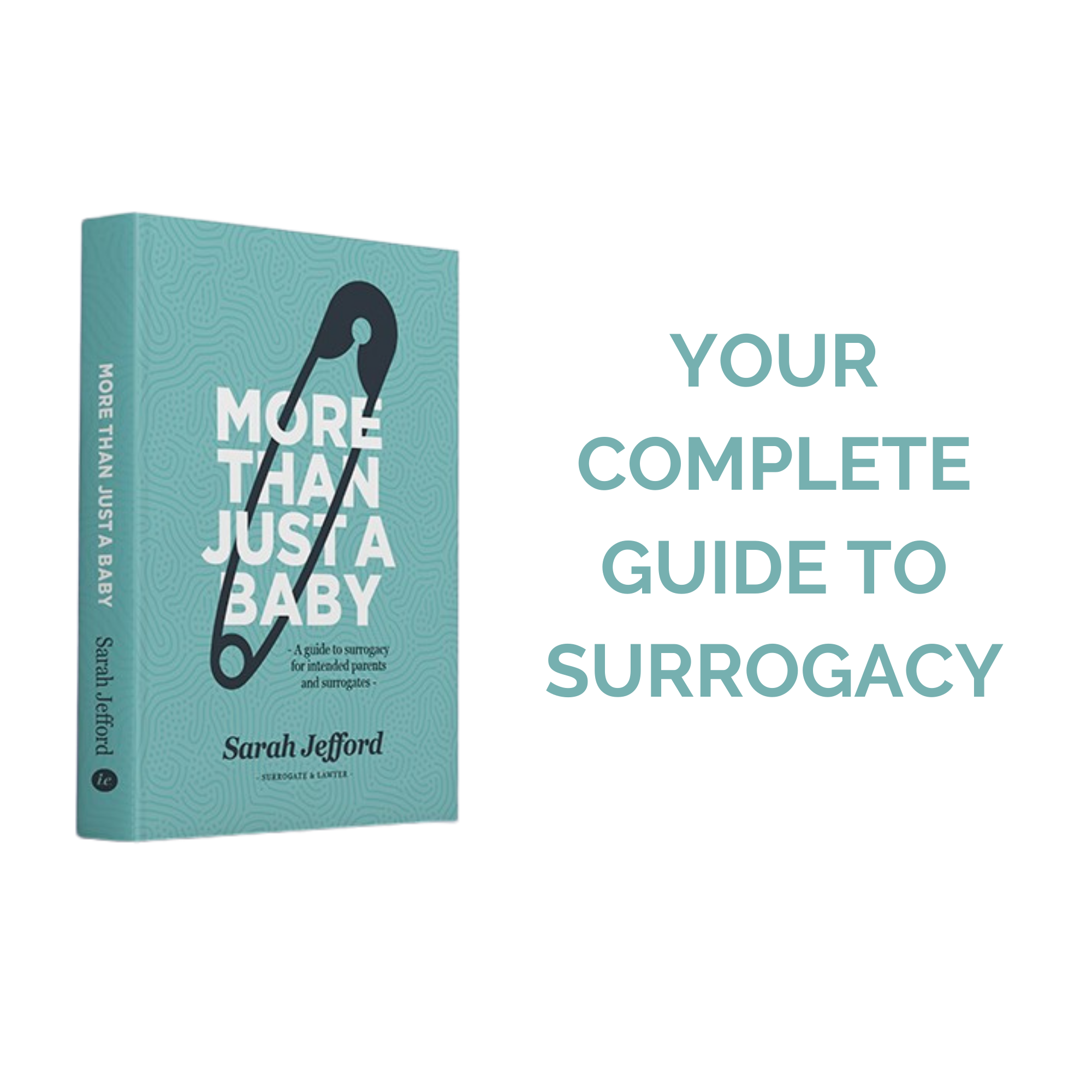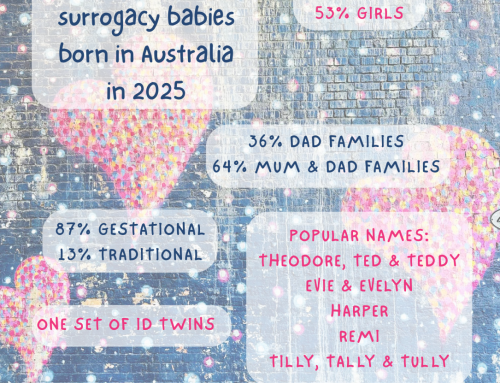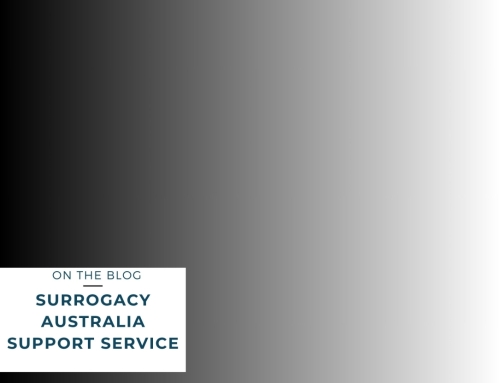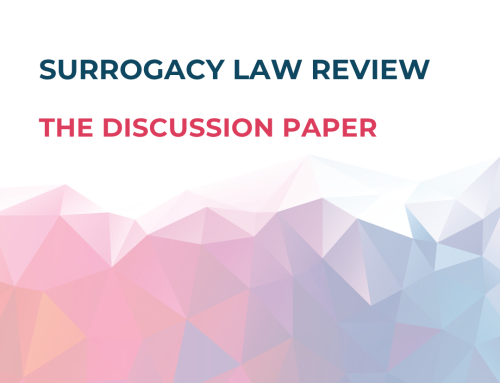Surrogacy Case Updates
As one of only a few surrogacy lawyers in Australia, it can be difficult to stay on top of case law, particularly without a specific professional practice group. That may change with the inaugural Fertility Law and Ethics conference in October 2025, bringing together fertility and surrogacy legal and counselling practitioners and allied professionals.
I have collated a few surrogacy cases of recent years that help guide and develop our practice. I keep an eye out for surrogacy and parentage cases on Jade’s database of legislation and caselaw.
Particular cases of note in 2025 are outlined in this separate article and you can read the November 2025 Surrogacy & Fertility Bulletin.
In no particular order, here are a few surrogacy case updates, hyperlinked so you can read the full judgement, to keep in mind:
Lamb and Anor & Shaw [2017] FamCA 769 – surrogacy – parentage – change of birth registration – no parentage order under the Surrogacy Act.
Lamb is a case that had several judgements, all of which can be read on Jade. The 2017 judgement is the primary judgement and details the background more than the later appeal judgements. The parties included the intended parents, and a third cousin of the intended mother acting as their surrogate. The relationship broke down early in the pregnancy, with lawyers involved, and the surrogate threatening to terminate the pregnancy and involving adoption authorities at the birth. Ultimately, the baby was relinquished to the intended parents, but the surrogate refused to consent to a parentage order. The intended parents sought orders for shared parental responsibility in the Family Court, and to include the intended father on the child’s birth certificate which only listed the surrogate as the child’s parent.
Of note is paragraph 29, which refers to the conduct of the surrogate’s lawyer, who wrote to the intended parents and implicitly threatened that the surrogate would not relinquish the child and that she might take her story to the media, and that the intended parents could be liable for costs of $20,000 or more. The lawyer included their 13 page CV as part of the letter, which is an interesting practice I’m not familiar with. The Judge was critical of the letter and noted the negative impact it had on the parties’ relationship. In my experience, the conduct of a lawyer in a surrogacy arrangement is crucial in managing the heightened emotions and can have a huge impact on the parties’ relationships.
Issues arising included the pre surrogacy counselling, the surrogate’s mental health and suitability to enter a surrogacy arrangement, and of course issues of parentage and parental responsibility. The hospital had a lot to deal with, and illustrates why clear hospital policy is crucial in a surrogacy arrangement. The full judgement is quite the read.
Ultimately, the intended parents were granted parental responsibility for the child, and were able to change the child’s name. Orders were made that the child spend no time with the surrogate, and that the intended father’s name be registered on the child’s birth certificate.
Lessons from Lamb: Does it need to be said that lawyers should do no harm? Well, experienced surrogacy lawyers know that inflaming the parties and pitting them against each other serves no one’s interests and certainly not that of the child.
Lamb also demonstrates the importance of having experienced surrogacy counsellors involved, and for psychometric testing of surrogates and intended parents. The parties should be prepared for a lifelong friendship. Professionals should be ensuring the parties have the tools and resilience to manage the challenges and complexities of surrogacy.
.
Re L; Application for Parentage Order [2022] NSWSC 1155 – non-mandatory preconditions of a parentage order – counselling must be completed prior to entering a surrogacy arrangement.
Re L is a case where the parties signed the surrogacy agreement before completing counselling. The parties signed the agreement in February, but counselling was not completed until early March. Under the NSW Surrogacy Act, counselling (section 35(1)) and legal advice (section 36) must be completed prior to entering the surrogacy arrangement.
In Re L, Judge Parker considered whether exceptional circumstances justified the making of the order, which is required where preconditions have not been met. His Honour noted that while the surrogacy agreement was signed prior to counselling, pregnancy attempts did not occur until after counselling had been completed. His Honour also considered that it was in the best interests of the child that the order be made and noted that counselling had been completed, even if the timelines were not completed appropriately.
Lessons from Re L: The parties, counsellors and lawyers must ensure that the pre-surrogacy steps are all completed in appropriate order to ensure compliance and to avoid compromising the parentage order. Counselling and legal advice must be completed before signing the agreement, and the agreement must be signed before pregnancy attempts.
.
Seto & Poon [2021] FamCA 288 – illegal commercial surrogacy arrangement – parenting proceedings – lawyer conduct.
Seto & Poon is a Family Court case, involving an agreement between the parties to enter a surrogacy arrangement. They did not meet any of the pre-surrogacy requirements under the Surrogacy Act, and the case was dealt with in the Family Court as a parenting matter.
Seto is a long and complex case involving commercial surrogacy, in breach of the Surrogacy Act, and where the intended parents promised to pay the surrogate over $100,000 in exchange for ‘two babies.’ The details became pretty sordid, with the surrogate and the intended father presenting to an IVF clinic as a couple, the surrogate’s lawyer demanding more than $300,000 for expenses including cosmetic surgery, and the children living temporarily with the surrogate. A complete mess and an indictment on all the parties and the lawyer. The lawyer was referred to the Legal Services Commission for disciplinary proceedings.
Ultimately, the intended parents were awarded parental responsibility for both children.
Lessons from Seto: Does it need to be said? Commercial surrogacy is illegal. Everyone involved in a surrogacy arrangement must behave ethically, and lawyers must adhere not only to the Surrogacy Act but also to the legal profession conduct rules.
.
Re Ashley [2023] NSWSC 1295 – surrogacy agreement must be entered into after counselling and legal advice and prior to conception.
Re Ashley is another case, like Re L above and Re M below, where relatively simple mistakes risked the parentage order. In this case, the parties completed counselling and legal advice, but did not sign the agreement prior to conception. The agreement had been drafted, but was not signed. There wasn’t an explanation as to why this was the case. His Honour Judge Meek found that an oral agreement existed and that it was in the child’s best interests that the parentage order be made.
Lessons from Re Ashley: Get that agreement signed! As with Re L, it’s important that the parties, counsellors and lawyers adhere to the Surrogacy Act and the pre-surrogacy requirements. Clinics are also bound by NHMRC Guidelines not to perform any embryo transfers without a signed agreement on file. When I hassle my clients to get that agreement signed, there’s a good reason for this!
.
RPR & Anor v TMK & Anor [2021] QChC 4 – intended parents not resident in Queensland – dispensation of requirement – exceptional circumstances.
RPR v TMK was a COVID lockdowns story of a surrogacy arrangement. The intended parents intended to move from Victoria to Queensland during the surrogacy process but by the time their baby was due to be born, life and COVID travel restrictions got in the way and they stayed in Victoria. The intended parents did not meet the criteria for a parentage order in Victoria, so they applied to the Queensland Children’s Court and sought that the requirement for them to be residents in Queensland be dispensed with.
Judge Richards made the parentage order, noting that it was in the child’s best interests. Her Honour considered that she had discretion to find that exceptional circumstances existed.
Lessons from RPR v TMK: We can always learn with 20:20 (or is it 2020!) hindsight. If intended parents are thinking about moving interstate before, during or after the surrogacy, they and their lawyer need to consider the impact on future parentage order applications, and which jurisdiction they intend to seek an order.
.
Long v Secretary, Department of Education [2023] NSWCATAP 14 – anti-discrimination – paid parental leave – altruistic surrogacy.
Long is not a surrogacy case, but a civil matter involving parental leave and alleged discrimination. The applicant was the biological father of two children born via surrogacy in Mexico. He was an employee of the NSW Department of Education, and applied for employee paid parental leave to care for his children.
Mr Long was granted paid parental leave on condition that he had entered an altruistic surrogacy arrangement and that he would obtain a parentage under the NSW Surrogacy Act. When the Department sought confirmation of the parentage order, Mr Long complained that he had been subject to discrimination. He noted that female staff members delivering a baby were not required to obtain proof of a parentage order, and that he had care responsibilities for his children and therefore should have been granted unconditional paid parental leave.
The Department of Education Teacher’s Handbook provides that altruistic surrogacy leave is available for all employees entering a surrogacy arrangement. The Tribunal found that there had been no discrimination against Mr Long on the basis of sexuality or gender, noting that all employees engaging in surrogacy were subject to the same conditions.
Lessons from Long: Intended parents and surrogates should research their employee benefits for surrogacy parental leave and care giving, prior to entering a surrogacy arrangement. Intended parents entering surrogacy arrangements overseas should consider their entitlements, and seek legal advice, prior to entering an arrangement.
.
Tickner v Rodda [2021] FedCFamC1F 279 – surrogacy – termination of surrogacy arrangement.
A sad and sordid tale of surrogacy gone wrong, the parties’ relationship broke down early in the pregnancy. The surrogate told the intended parents that she had terminated the pregnancy. She went on to deliver a healthy full-term baby, and did not relinquish him to the intended parents. They subsequently sought urgent parenting orders in the Family Court for the child to be placed in their care.
This case ultimately resolved by consent, with the surrogate relinquishing the child to the intended parents. Final Orders were made that granted the intended parents shared parental responsibility for the child.
Had the case not resolved by the consent, it would have been the only case in Australia where a court would have had to determine the care of a child born via surrogacy where the surrogate had not relinquished the baby.
Lessons from Tickner: Above all else, surrogacy arrangements are not enforceable, and the Judge noted that the proceedings had ‘the flavour of enforcement.’ Parties should receive legal advice that the arrangement is not enforceable, that the surrogate retains her bodily autonomy and the child’s best interests are paramount.
The parties had completed the necessary pre surrogacy counselling and legal advice. Could the outcome have been avoided? Perhaps not. The professionals can only work with the information they have to hand at the time. Lawyers advising in surrogacy arrangements should have sufficient understanding of surrogacy before advising in this practice area; inexperience can inflame conflict between the parties.
.
A v X; Re Z [2022] NSWSC 971 – application for parentage order where the child was stillborn – whether a parentage order can be made.
A v X was a very sad case where the surrogate delivered a stillborn baby. The intended parents applied for a parentage order, to be recognised as the child’s parents on the birth certificate.
Judge Darke considered that while the parties all desired the parentage order, they did not meet the preconditions. The preconditions include requirements for the child to born subject to the surrogacy arrangement, for the order to be in the best interests of the child and that the child is living with the intended parents at the time of the hearing. His Honour considered that the baby, Z, was not ‘born’ of the surrogacy arrangement because she was stillborn, and that the other preconditions could not be met.
Lessons from A v X: Parties and their lawyers should discuss arrangements in case the pregnancy is terminated or baby is stillborn. Surrogacy laws around Australia expect the child to be living with the intended parents at the time of the parentage order – and this cannot be satisfied in the case of a stillborn baby. Parties should discuss funeral arrangements and how they might otherwise recognise and celebrate baby’s parentage.
.
Altimari & Altimari [2024] FedCFamC1F 3 – parentage where one intended parent did not enter the surrogacy arrangement.
Altimari is a case where one intended parent, A, entered a surrogacy arrangement and baby Y arrived. A obtained a parentage order under the NSW Surrogacy Act. A’s ex-partner, B, also provided care and parented Y, notwithstanding that he had not participated in the pre-surrogacy processes of counselling and legal advice. Both A and B sought orders in the Family Court for a declaration that B was a parent of Y, or alternatively that he adopt Y.
A and B had been in a relationship together, had an older child together, and separated before A proceeded with a second surrogacy arrangement.
Judge Gill of the FCFCOA considered that B did not meet the criteria for a declaration of parentage under the ACT’s Parentage Act, partly because he was not in a relationship with A.
Lessons from Altimari: Relationships change all the time. Parties and their lawyers need to canvass potential relationship changes that may occur before, during or after entering a surrogacy arrangement and the consequences for parentage in the future.
.
Re M; Application for Parentage Order [2023] NSWSC 531 – definition of ‘signing’ an agreement.
M and A were twins born via surrogacy in New South Wales. The parties met all the preconditions for a parentage order, however the surrogate had signed the agreement electronically, with a typewritten name rather than by hand, and so had her witness. Judge Parker considered whether an electronic signature was sufficient under the Surrogacy Act. Ultimately, His Honour found that an electronic signature was sufficient and noted that modern times allowed for electronic signing. However, His Honour was concerned that an electronic signature might be considered differently to a typewritten name, given the difficulty in determining the identity of the signatory with a typed name. He was satisfied that the surrogate had placed her name on the agreement and ultimately made the order.
Lessons from Re M: As with Re Ashley, we need to make sure the signed agreement can be used as evidence for the parentage order. Electronic signatures might be satisfactory, but we need to be able to verify that the parties themselves ‘signed’ the agreement. It is best to sign with a signature rather than a typed name.
.
Further surrogacy case updates in 2025 are outlined in this article.
What do you think? Did you find the surrogacy case updates useful? Surrogacy laws differ between each state. Sarah has published a book, More Than Just a Baby: A Guide to Surrogacy for Intended Parents and Surrogates, the only guide to surrogacy in Australia.
You can find more information in the free Surrogacy Handbook, reading articles in the Blog, by listening to more episodes of the Surrogacy Podcast. You can also book in for a consult with me below, and check out the legal services I provide.

